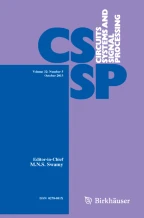Abstract
The modified filtered-x affine projection (MFxAP) algorithm is effective for active noise control owing to its good convergence behavior and medium computational burden. The transient and steady-state performances of the MFxAP algorithm have been analyzed in previous studies, which presented a relatively good agreement between the theory and measured results. However, the correlation between the weight-error vector and the past noise vectors is disregarded in the existing methods. Hence, a more accurate theoretical analysis for the MFxAP algorithm is presented herein, in which the effect of the past noise vector on the weight-error vector is considered comprehensively. Simulation results indicate that the proposed theoretical results match the experimental results more precisely than the previous studies, in particular, at the steady state.
Similar content being viewed by others
References
F. Albu, Efficient multichannel filtered-x affine projection algorithm for active noise control. Electron. Lett. 42(7), 421–423 (2006)
F. Albu, M. Bouchard, Y. Zakharov, Pseudo-affine projection algorithms for multichannel active noise control. IEEE Trans. Audio Speech Lang. Process. 15(3), 1044–1052 (2007)
F. Albu, Y. Zakharov, C. Paleologu, Modified filtered-x dichotomous coordinate descent recursive affine projection algorithm, in 2009 IEEE International Conference on Acoustics, Speech and Signal Processing (2009), pp. 257–260
N.J. Bershad, D. Linebarger, S. McLaughlin, A stochastic analysis of affine projection algorithm for gaussian autoregressive inputs, in IEEE International Conference on Acoustics Speech and Signal Processing (2001), pp. 3837–3840
E. Bjarnason, Analysis of the filtered-X LMS algorithm, in IEEE International Conference on Acoustics Speech and Signal Processing Proceedings, vol. 3 (1993), pp. 511–514
M. Bouchard, Multichannel affine and fast affine projection algorithms for active noise control and acoustic equalization systems. IEEE Trans. Speech Audio Process. 16(4), 13–41 (1999)
A. Carini, G.L. Sicuranza, Analysis of a multichannel filtered-x set membership affine projection algorithm, in IEEE International Conference on Acoustics Speech and Signal Processing (2006a), pp. 2644–2647
A. Carini, G.L. Sicuranza, Transient and steady-state analysis of filtered-x affine projection algorithm. IEEE Trans. Signal Process. 54(2), 665–678 (2006b)
A. Carini, G.L. Sicuranza, Analysis of transient and steady-state behavior of a multichannel filtered-x partial-error affine projection algorithm. EURASIP J. Audio Speech Music Process. 1, 9–9 (2007)
P.S.R. Diniz, Convergence performance of the simplified set-membership affine projection algorithm. Circuits Syst. Signal Process. 30(2), 439–462 (2011)
S.C. Douglas, The fast affine projection algorithm for active noise control. Asilomar Conf. Signals 2, 1245–1249 (1995)
S.J. Elliott, P.A. Nelson, Active noise control. IEEE Signal Process. Mag. 10(4), 12–35 (1993)
M. Ferrer, A. Gonzalez, M. de Diego, G. Piñero, Fast affine projection algorithms for filtered-x multichannel active noise control. IEEE Trans. Audio Speech Lang. Process. 16(8), 1396–1408 (2008)
M. Ferrer, A. Gonzalez, M. de Diego, G. Piñero, Transient analysis of the conventional filtered-x affine projection algorithm for active noise control. IEEE Trans. Audio Speech Lang. Process. 19(3), 652–657 (2011)
M. Ferrer, A. Gonzalez, M. de Diego, G. Piñero, Steady-state mean square performance of the multichannel filtered-x affine projection algorithm. IEEE Trans. Signal Process. 60(6), 2771–2785 (2012)
A. González, M. Ferrer, M. de Diego, L. Fuster, Efficient implementation of matrix recursions in the multichannel affine projection algorithm for multichannel sound, in IEEE Workshop on Multimedia Signal Processing (2004), pp. 215–218
Y. Kajikawa, W.S. Gan, S.M. Kuo, Recent advances on active noise control: open issues and innovative applications. APSIPA Trans. Signal Inf. Process. 1(2), e3 (2012)
S.E. Kim, J.W. Lee, W.J. Song, A theory on the convergence behavior of the affine projection algorithm. IEEE Trans. Signal Process. 59(12), 6233–6239 (2011)
S.M. Kuo, D.R. Morgan, Active Noise Control Systems: Algorithms and DSP Implementations (Wiley, New York, 1996)
M.V. Lima, P.S. Diniz, Steady-state mse performance of the set-membership affine projection algorithm. Circuits Syst. Signal Process. 32(4), 1811–1837 (2013)
T.K. Moon, W.C. Stirling, Mathematical Methods and Algorithms for Signal Processing (Prentice-Hall, New York, 2000)
T.K. Paul, T. Ogunfunmi, On the convergence behavior of the affine projection algorithm for adaptive filters. IEEE Trans. Circuits Syst. I Regul. Pap. 58(8), 1813–1826 (2011)
S.G. Sankaran, A.A.L. Beex, Convergence behavior of affine projection algorithms. IEEE Trans. Signal Process. 48, 1086–1096 (2000)
H.C. Shin, A.H. Sayed, Mean-square performance of a family of affine projection algorithms. IEEE Trans. Signal Process. 52(1), 90–102 (2004)
D.T.M. Slock, On the convergence behavior of the LMS and normalized LMS algorithms. IEEE Trans. Signal Process. 41(9), 2811–2825 (1993)
F. Yang, J. Yang, A comparative survey of fast affine projection algorithms. Digit. Signal Process. 83, 297–322 (2018)
F. Yang, M. Wu, J. Yang, Z. Kuang, A fast exact filtering approach to a family of affine projection-type algorithms. Signal Process. 101, 1–10 (2014)
Acknowledgements
This work was supported by Youth Innovation Promotion Association of Chinese Academy of Sciences under Grant 2018027, the Strategic Priority Research Program of Chinese Academy of Sciences under Grant XDC02020400, IACAS Young Elite Researcher Projects QNYC201812 and QNYC201722, National Key R&D Program of China under Grant 2017YFC0804900, and National Natural Science Foundation of China under Grants 61501449, 11674348, and 11804368.
Author information
Authors and Affiliations
Corresponding authors
Additional information
Publisher's Note
Springer Nature remains neutral with regard to jurisdictional claims in published maps and institutional affiliations.
Appendix A
Appendix A
From (17), we expand the term \(\prod \nolimits _{l = 0}^{k - 1} {\left( {{\mathbf{{I}}_L} - \mu \mathbf{{P}}(n - l)} \right) }\) as follows:
where \(\mathbf{{G}}_k^l\left( {\mathbf{{P}}(n)} \right) \) is the coefficient related to \({( - \mu )^l}\) which can be written as
In particular, \(\mathbf{{G}}_k^0\left( {\mathbf{{P}}(n)} \right) = {\mathbf{{I}}_L}\).
Rights and permissions
About this article
Cite this article
Guo, J., Yang, F. & Yang, J. Mean-Square Performance of the Modified Filtered-x Affine Projection Algorithm. Circuits Syst Signal Process 39, 4243–4257 (2020). https://doi.org/10.1007/s00034-020-01365-2
Received:
Revised:
Accepted:
Published:
Issue Date:
DOI: https://doi.org/10.1007/s00034-020-01365-2
